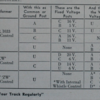I am trying to wire my four 022 switches using the fixed voltage plugs. I am powering the track with a KW Multi-Control Trainmaster Transformer. I have purchased at 1033 transformer that I would like to use to power the switches.
To power the track I have three clip-ons that are connected to the KW transformer through a MTH 50 1014 port terminal block.
I have attempted to connect the switches to the A-C-U on the 1033 transformer as per the wiring diagram in the 1033 Operating Instructions. I have tried routing the wire connecting the A terminal to the port terminal block. With this wiring when I begin to run the train the lights on the switches dim.
So instead of wiring through the port terminal block, I wired directly to a fourth clip on. When I do this the 1033 transformer will operate the train.
What am I doing wrong?
Thanks in advance for your help.






